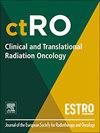未切除的少转移性肝病不同放疗方式的剂量学比较
IF 2.7
3区 医学
Q3 ONCOLOGY
引用次数: 0
摘要
目的随着各种可行的技术手段的出现,放射治疗在局限性肝转移中的作用正在迅速显现。在这里,我们提供了三种不同的放射治疗方式对未切除肝转移的剂量比较。方法本多中心研究纳入30例既往单发肝转移患者。间隙性高剂量率近距离放射治疗(HDR)、立体定向体放射治疗(SBRT)和千伏电子近距离放射治疗(eBT)作为在这种情况下的新模式,计划使用25 gy的单一分数并进行剂量学比较。主要终点是健康肝组织暴露的差异。次要终点包括靶体积覆盖、周围危险器官的剂量(OARs)和放射治疗时间。结果病灶体积中位数(范围)为9.3 (2.5 ~ 29.7)cm3。与SBRT相比,电子BT产生了明显更好的桨叶剂量节约。与SBRT (98.8 [54.3-303.7] cm3相比,eBT (V9.1 Gy 13.8 [3.4-41.6] cm3)和HDR (49.2 [12.7-116.8] cm3)对健康肝脏的辐射暴露显著降低;p & lt;两者均为0.001)。SBRT的平均治疗时间最短(6.1分钟,HDR为7.8分钟[p = 0.003], eBT为16.1分钟[p <;0.001])。同样,CTV的D90%和D95%优于SBRT (p <;0.001 vs. HDR和eBT)。结论微创单导管eBT为不可切除的肝转移提供了一种新的治疗方法,具有最佳的OAR剂量节约,但靶体积覆盖不理想。结合这两种方式的优势,多住宅eBT方法如HDR可以简化临床常规的适用性,优化目标覆盖,同时保持良好的OAR剂量。未来的前瞻性研究需要进一步确定其在成熟的肝脏定向治疗中的作用。本文章由计算机程序翻译,如有差异,请以英文原文为准。
A dosimetric comparison of different radiotherapy modalities for Non-Resected oligometastatic liver Disease
Purpose
The role of radiotherapy in the context of limited liver metastases is emerging rapidly with a variety of available technical approaches. Here, we provide a dosimetric comparison of three different radiotherapy modalities for non-resected liver metastases.
Methods
This multicentric study included 30 patients previously treated for solitary liver metastases. Interstitial high dose-rate brachytherapy (HDR), stereotactic body radiation therapy (SBRT), and kilovoltage electronic brachytherapy (eBT) with a single dwelling point, as an in this context novel modality, were planned with a 25-Gy single fraction and dosimetrically compared. The primary endpoint was difference in healthy liver tissue exposure. Secondary endpoints included target volume coverage, dose to the surrounding organs at risk (OARs), and radiation treatment time.
Results
The median (range) lesion volume was 9.3 (2.5 − 29.7) cm3. Electronic BT yielded a significantly better OAR dose sparing compared to SBRT. Radiation exposure to the healthy liver was significantly lower with eBT (V9.1 Gy 13.8 [3.4–41.6] cm3) and HDR (49.2 [12.7–116.8] cm3) when compared with SBRT (98.8 [54.3–303.7] cm3; p < 0.001 for both). Mean treatment time was shortest for SBRT (6.1 min vs. 7.8 min for HDR [p = 0.003] vs. 16.1 min for eBT [p < 0.001]). Equally, CTV D90% and D95% were superior for SBRT (p < 0.001 vs. HDR and eBT).
Conclusion
Minimally invasive single-catheter eBT provides a new potential approach in the context of unresectable liver metastases, with optimal OAR dose sparing, yet suboptimal target volume coverage. Combining the advantages of both modalities, a multi-dwelling eBT approach as in HDR might ease applicability in clinical routine with optimized target coverage while maintaining excellent OAR doses. Future prospective investigations are required to further define its role within well-established liver-directed therapies.
求助全文
通过发布文献求助,成功后即可免费获取论文全文。
去求助
来源期刊

Clinical and Translational Radiation Oncology
Medicine-Radiology, Nuclear Medicine and Imaging
CiteScore
5.30
自引率
3.20%
发文量
114
审稿时长
40 days
 求助内容:
求助内容: 应助结果提醒方式:
应助结果提醒方式:


